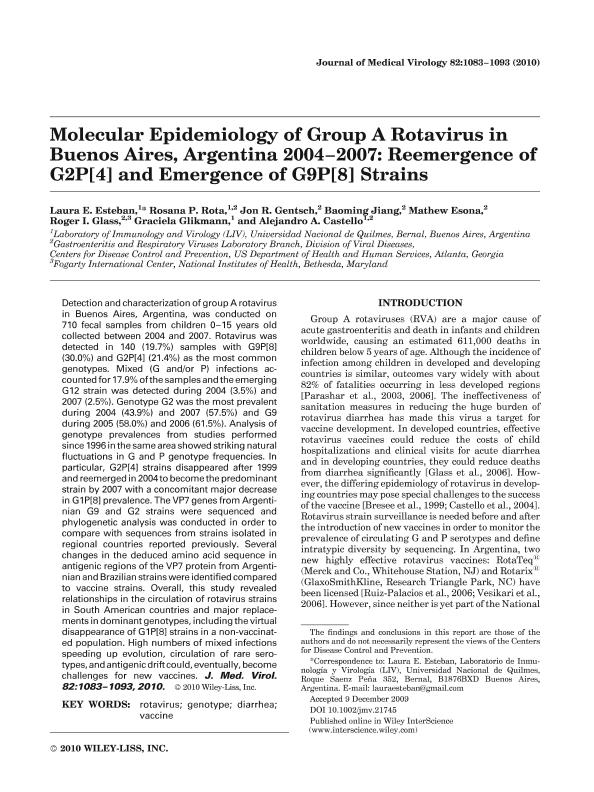Artículo
Molecular epidemiology of group A rotavirus in Buenos Aires, Argentina 2004-2007: reemergence of G2P[4] and emergence of G9P[8] strains
Esteban, Laura Emilia ; Rota, Rosana Paola
; Rota, Rosana Paola ; Gentsch, Jon R.; Jiang, Baoming; Esona, Mathew; Glass, Roger I.; Glikmann, Graciela; Castello, Alejandro Andrés
; Gentsch, Jon R.; Jiang, Baoming; Esona, Mathew; Glass, Roger I.; Glikmann, Graciela; Castello, Alejandro Andrés
 ; Rota, Rosana Paola
; Rota, Rosana Paola ; Gentsch, Jon R.; Jiang, Baoming; Esona, Mathew; Glass, Roger I.; Glikmann, Graciela; Castello, Alejandro Andrés
; Gentsch, Jon R.; Jiang, Baoming; Esona, Mathew; Glass, Roger I.; Glikmann, Graciela; Castello, Alejandro Andrés
Fecha de publicación:
05/2010
Editorial:
Wiley-liss, div John Wiley & Sons Inc.
Revista:
Journal of Medical Virology
ISSN:
0146-6615
Idioma:
Inglés
Tipo de recurso:
Artículo publicado
Clasificación temática:
Resumen
Detection and characterization of group A rotavirus in Buenos Aires, Argentina, was conducted on 710 fecal samples from children 0-15 years old collected between 2004 and 2007. Rotavirus was detected in 140 (19.7%) samples with G9P[8] (30.0%) and G2P[4] (21.4%) as the most common genotypes. Mixed (G and/or P) infections accounted for 17.9% of the samples and the emerging G12 strain was detected during 2004 (3.5%) and 2007 (2.5%). Genotype G2 was the most prevalent during 2004 (43.9%) and 2007 (57.5%) and G9 during 2005 (58.0%) and 2006 (61.5%). Analysis of genotype prevalences from studies performed since 1996 in the samearea showed striking natural fluctuations in G and P genotype frequencies. In particular, G2P[4] strains disappeared after 1999 and reemerged in2004 to become the predominant strain by 2007 with a concomitant major decrease in G1P[8] prevalence. The VP7 genes from Argentinian G9 and G2 strains were sequenced and phylogenetic analysis was conducted in order to compare with sequences from strains isolated in regional countries reported previously. Several changes in the deduced amino acid sequence in antigenic regions of the VP7 protein from Argentinian and Brazilian strains were identified compared to vaccine strains. Overall, this study revealed relationships in the circulation of rotavirus strains in South American countries and major replacements in dominant genotypes, including the virtual disappearance of G1P[8] strains in a non-vaccinated population. High numbers of mixed infections speeding up evolution, circulation of rare serotypes, and antigenic drift could, eventually,become challenges for new vaccines.
Palabras clave:
DIARRHEA
,
GENOTYPE
,
ROTAVIRUS
,
VACCINE
Archivos asociados
Licencia
Identificadores
Colecciones
Articulos(SEDE CENTRAL)
Articulos de SEDE CENTRAL
Articulos de SEDE CENTRAL
Citación
Esteban, Laura Emilia; Rota, Rosana Paola; Gentsch, Jon R.; Jiang, Baoming; Esona, Mathew; et al.; Molecular epidemiology of group A rotavirus in Buenos Aires, Argentina 2004-2007: reemergence of G2P[4] and emergence of G9P[8] strains; Wiley-liss, div John Wiley & Sons Inc.; Journal of Medical Virology; 82; 6; 5-2010; 1083-1093
Compartir
Altmétricas



